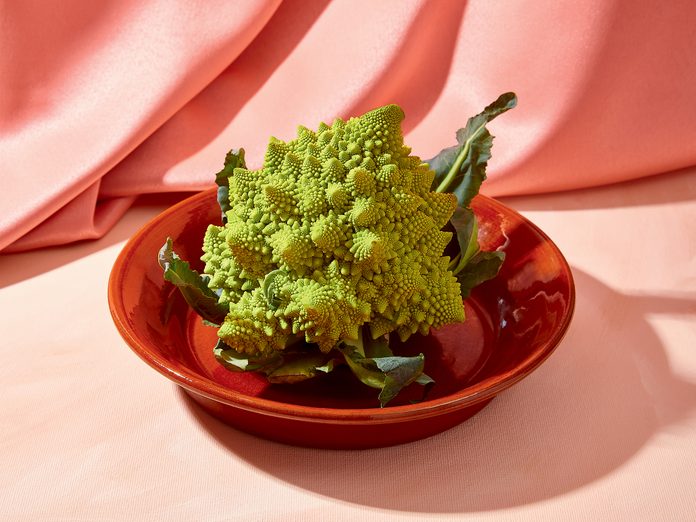What are the Health Benefits of Romanesco?

This whimsical broccoli-cauliflower hybrid is almost too pretty to eat. (Almost.)
Romanesco, the whimsical, psychedelic star of the produce section, is a broccoli-cauliflower hybrid chock full of vitamins and minerals. It’s almost too pretty to eat. Almost. The key to enjoying more of it starts with letting high heat do its thing, and making sure to not overcook it.
(Related: 30 Flavour-Packed Citrus Recipes That Taste Like Spring)
What is romanesco
Romanesco, also called Roman cauliflower, hails from Northern Italy and is a striking bright lime-green colour. This cool-season vegetable is available from spring to fall and is part of the Brassica family of vegetables (think cauliflower, kale, broccoli and cabbage) but has its own distinctive shape and sweet, nutty flavour.
Romanesco has tightly packed florets that are clustered in pointed spiral shapes instead of rounded like broccoli and cauliflower. Romanesco’s unique look takes its cues from mathematics — it’s a textbook example of a logarithmic shape called a fractal (math-speak for infinitely repeating patterns of smaller shapes creating one big shape). In the case of romanesco, each spiked floret is made up of many smaller points, creating a mesmerizing, kaleidoscopic design.
(Related: How to Choose a Healthy Bread)
Why it’s good for you
Not only is romanesco visually appealing, but it’s also packed with nutrients, like vitamins A, C and K, calcium and iron. The body absorbs calcium and iron more easily from brassicas like romanesco compared to other vegetables. This makes them especially important to include if you’re following a plant-based diet, which makes it challenging to get sufficient levels of these minerals from your food. Romanesco is also high in cholesterol-lowering fibre — there’s about four grams in one cup.
Studies have noted a decrease in the risk of developing colorectal and other cancers in those who eat more brassicas, like romanesco, broccoli and cauliflower. This can be attributed to compounds naturally found in brassicas called glucosinolates.
Glucosinolates are biologically active compounds that are by-products of sulphur, and romanesco is rich in sulphur-containing compounds. Released from plant cell walls when they’re broken down by chewing or processing, glucosinolates form a variety of compounds that act as antioxidants. Research has found that these compounds help prevent the activation of cancer-causing molecules in the body; they also reduce inflammation by triggering detoxification enzymes that clear free radicals and set off immune functions. Glucosinolates have also been shown to have antibacterial and antifungal properties, helping you fend off infection.
(Related: What Are the Health Benefits of Mushrooms?)
How to pick and store it
Look for one that still has crisp-looking leaves attached — a sign of freshness. The head of the romanesco should be bright green and feel firm and heavy.
Cooking and storage methods will affect the levels of anti-inflammatory compounds and vitamins in romanesco. Once home, store your romanesco in a plastic bag in the fridge, and eat it within a week of purchasing to exploit peak glucosinolate content. Reduce nutrient loss during cooking by baking or roasting it — boiling can cause water-soluble C and B vitamins to leach into the cooking liquid.
(Related: What You Need to Know About Seitan, The Latest Plant-Based Protein Craze)
How to cook with it
The key to preparing romanesco is not to overcook it. The best way to maintain its spectacular shape — and avoid turning it into mush — is to roast, pan-fry or grill it in large chunks. Its firm texture stands up well to high heat, which will also enhance romanesco’s naturally sweet flavour. Serve roasted quartered romanesco as a side dish, sauté smaller pieces to add to pasta, or blanche florets and use as crudités to up the wow factor on a veggie platter.
Laura Jeha is a registered dietitian, nutrition counsellor and recipe developer. Find out more at ahealthyappetite.ca.
Now that you know about the health benefits of romanesco, try it in this delicious roasted romanesco with lemon-caper gremolata recipe.




